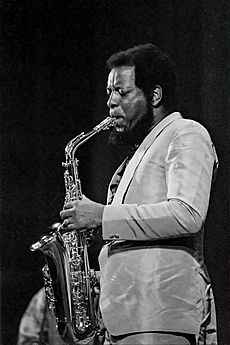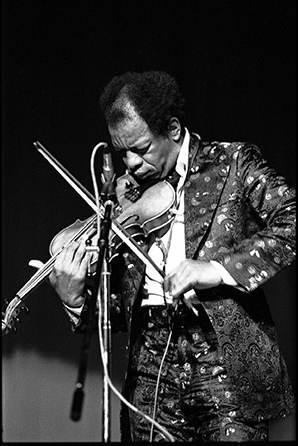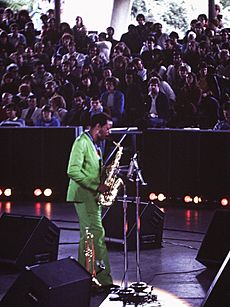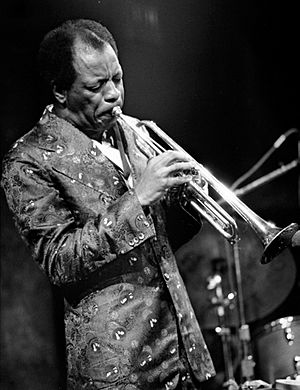Ornette Coleman facts for kids
Quick facts for kids Ornette Coleman |
|
|---|---|
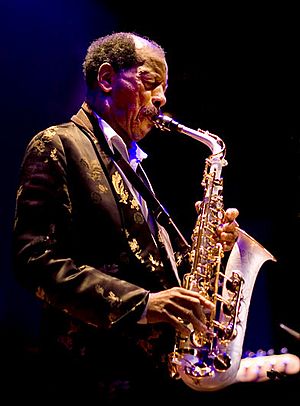
Coleman at the Enjoy Jazz Festival in Heidelberg, 2008
|
|
| Background information | |
| Birth name | Randolph Denard Ornette Coleman |
| Born | March 9, 1930 Fort Worth, Texas, U.S. |
| Died | June 11, 2015 (aged 85) New York City |
| Genres |
|
| Occupation(s) |
|
| Instruments | |
| Years active | 1940s–2015 |
| Labels | |
| Associated acts |
|
Randolph Denard Ornette Coleman (March 9, 1930 – June 11, 2015) was an American jazz musician. He played the saxophone, trumpet, and violin, and was also a composer. He is famous for helping to create a style of jazz called free jazz. This name came from his 1960 album, Free Jazz: A Collective Improvisation.
Coleman's music was different from earlier jazz. He often didn't use traditional harmony, fixed rhythms, or chord changes. Instead, he focused on experimental ways of making music up on the spot, called improvisation. His music often involved the whole group playing together and had a strong connection to the blues. Many people now see him as a brave and brilliant musician. However, when he first started, some musicians and critics thought his music was strange or even wrong.
Ornette Coleman grew up in Fort Worth, Texas. He taught himself to play the saxophone as a teenager. He began his career playing in local R&B and bebop bands. Later, he formed his own group in Los Angeles. This group included musicians like Ed Blackwell, Don Cherry, Charlie Haden, and Billy Higgins. In 1959, his quartet started playing at the Five Spot jazz club in New York City. This was a big deal and sometimes caused arguments. He also released his important album The Shape of Jazz to Come that year.
Coleman's albums in the early 1960s greatly changed jazz music. His songs "Lonely Woman" and "Broadway Blues" became well-known free jazz pieces. In the mid-1960s, he started working with his son, Denardo Coleman, who played drums. Coleman also explored classical music with his 1972 album Skies of America, which featured the London Symphony Orchestra. In the 1970s, he formed a group called Prime Time. With them, he explored electric jazz-funk and his own music idea called harmolodic music. In 2006, his album Sound Grammar won the Pulitzer Prize for Music. This made him only the second jazz musician to receive this special award.
Contents
Ornette Coleman's Life Story
Early Years and Musical Start
Ornette Coleman was born on March 9, 1930, in Fort Worth, Texas. He grew up there.
He went to I.M. Terrell High School. He was in the school band but was asked to leave. This happened because he started making up his own music during a march song. He began playing R&B and bebop music on the tenor saxophone. He also started a band called The Jam Jivers.
In 1949, he left Fort Worth to join a traveling show. Later, he joined other R&B shows. After one show, his saxophone was broken. He then switched to the alto saxophone, which became his main instrument. He played it first in New Orleans. Then he joined Pee Wee Crayton's band and moved to Los Angeles. He worked different jobs while trying to make it as a musician.
In California, he met other musicians who liked his style. These included Ed Blackwell, Bobby Bradford, Don Cherry, Charlie Haden, and Billy Higgins. In 1958, he recorded his first album, Something Else!!!!. Some people in the jazz world were surprised by his new sound. Some musicians called him a fake, but famous conductor Leonard Bernstein praised him.
1959: The Album That Changed Jazz
In 1959, Atlantic released Coleman's album The Shape of Jazz to Come. Music critic Steve Huey said this album was a huge moment for avant-garde jazz. It really shaped how this new style would develop. Jazzwise magazine even called it one of the top 100 jazz albums ever. Ornette once said that his song "Lonely Woman" from the album was inspired by seeing a rich woman who seemed very alone.
Coleman's quartet played for a long time at the Five Spot jazz club in New York City. Their performances were sometimes controversial. Famous musicians like Leonard Bernstein and Lionel Hampton were impressed and supported him. But trumpeter Miles Davis first said Coleman was "all screwed up." Later, Davis became a fan of Coleman's new ideas.
Coleman's unique sound in his early days came partly from his plastic saxophone. He bought it in Los Angeles in 1954 because he couldn't afford a metal one. At first, he didn't like how the plastic horn sounded.
On his Atlantic recordings, Coleman's bandmates were Don Cherry on cornet or pocket trumpet. Charlie Haden, Scott LaFaro, and later Jimmy Garrison played bass. Billy Higgins or Ed Blackwell played drums. All his recordings for Atlantic were later put together in a box set called Beauty Is a Rare Thing.
1960s: Free Jazz and Blue Note
In 1960, Coleman recorded Free Jazz: A Collective Improvisation. This album featured two quartets playing at the same time. It included Don Cherry and Freddie Hubbard on trumpet, Eric Dolphy on bass clarinet, Haden and LaFaro on bass, and both Higgins and Blackwell on drums. The album was recorded so that each quartet was heard in a different stereo channel. At 37 minutes, Free Jazz was the longest continuous jazz performance recorded at that time. It was also one of Coleman's most talked-about albums. The music had a steady but complex beat. One drummer played a regular rhythm, while the other played twice as fast. The main musical ideas were short, clashing fanfares. Each band member had a chance to play solos, but others could join in whenever they wanted.
Coleman just meant "free jazz" to be the album's title. But his growing fame made him a leader in new jazz ideas. Soon, "free jazz" became the name for a whole new style of music. Coleman himself wasn't always comfortable with this term. One reason might be that his music still had planned parts, not just random sounds. His melodies, though simple, reminded some of the melodies Charlie Parker wrote. So, his music was actually closer to the bebop style that came before it than many people thought.
After his time with Atlantic Records, in the early 1960s, Coleman's music became even more sharp and experimental. It became part of the avant-garde jazz movement, which grew partly from his ideas. After his quartet broke up, he formed a trio. This trio included David Izenzon on bass and Charles Moffett on drums. He also started playing the trumpet and violin, which he taught himself to play left-handed. He didn't use traditional playing techniques. Instead, he used these instruments to make big, wild sounds. His friend Albert Ayler helped him develop his trumpet and violin playing. Sometimes, Charlie Haden would join this trio, making it a quartet with two basses.
Coleman then signed with Blue Note. He recorded At the Golden Circle Stockholm with them. In 1966, he recorded The Empty Foxhole with his son, Denardo Coleman, who was only ten years old. Some musicians thought this was just a way to get attention. But Denardo had been studying drums for years. His playing was raw but full of energy. He played more like free jazz drummers than bebop drummers. Denardo later became his father's main drummer in the late 1970s.
Coleman formed another quartet. This group included Haden, Garrison, and Elvin Jones. Dewey Redman also joined, usually on tenor saxophone. On February 29, 1968, Coleman played live with Yoko Ono at Albert Hall. One of their songs was included on the album Yoko Ono/Plastic Ono Band (1970).
He continued to explore using string instruments in his music. This started with Town Hall, 1962 and led to his Skies of America album in 1972. Sometimes, using classical musicians helped him. For example, it allowed his group to play in the UK in 1965. At that time, there were limits on how many jazz musicians could perform there, but classical performers had no such limits.
Ornette Coleman's Later Music
1970s–1990s: Electric Sounds and Prime Time
Like Miles Davis before him, Coleman started using electric instruments. His 1976 album Dancing in Your Head was his first recording with the group that became Prime Time. This album featured electric guitars. Even though this was a new style for Coleman, his music still sounded like his earlier work. These performances had the same sharp melodies and group improvisations where everyone played together. Coleman called this harmolodics. The rhythm changed, but Coleman's way of playing with rhythm stayed the same.
In the 1980s, albums like Virgin Beauty and Of Human Feelings continued to use rock and funk rhythms. This style was sometimes called free funk. Jerry Garcia from the band Grateful Dead played guitar on three songs from Coleman's 1988 album Virgin Beauty. Coleman even played on stage with the Grateful Dead in 1993. He also worked with guitarist Pat Metheny on the album Song X (1985). Coleman wrote all the songs for that album.
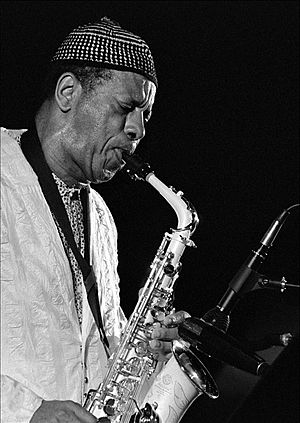
In 1990, the city of Reggio Emilia in Italy held a three-day festival about Coleman. It featured his quartet and performances of his classical music. In 1991, Coleman played on the music for David Cronenberg's movie Naked Lunch. This was special because it was rare to hear Coleman play a jazz standard, like "Misterioso" by Thelonious Monk. Two of Coleman's earlier recordings were used in the 2000 movie Finding Forrester. In 1995 and 1996, Coleman released four albums. For the first time in many years, he regularly worked with piano players like Geri Allen or Joachim Kühn.
2000s: Later Career and Awards
In September 2006, he released a live album called Sound Grammar. He played with his son, Denardo Coleman, and two bassists, Greg Cohen and Tony Falanga. This was his first album with new music in ten years. It was recorded in Germany in 2005. In 2007, it won the Pulitzer Prize for music. This made Coleman only the second jazz musician to win this award. While Wynton Marsalis won the Pulitzer in 1997 for a large musical work, Sound Grammar was the first jazz album to win the prize.
Jazz pianist Joanne Brackeen said in an interview that Coleman was her mentor and gave her music lessons.
Coleman married poet Jayne Cortez in 1954. They had one son, Denardo, born in 1956. They divorced in 1964.
Ornette Coleman passed away from a heart attack on June 11, 2015, in New York City. He was 85 years old. His funeral was a three-hour event with music and speeches from many of his friends and fellow musicians.
Awards and Honors
- Down Beat Jazz Hall of Fame, 1969
- MacArthur Fellowship, 1994
- Praemium Imperiale, 2001
- Dorothy and Lillian Gish Prize, 2004
- Honorary doctorate of music, Berklee College of Music, 2006
- Grammy Lifetime Achievement Award, 2007
- Pulitzer Prize for music, 2007
- Miles Davis Award, Festival International de Jazz de Montréal, 2009
- Honorary doctorate by the Graduate Center, CUNY, 2008
- Honorary doctorate of music, University of Michigan, 2010
Discography
Images for kids
See also
 In Spanish: Ornette Coleman para niños
In Spanish: Ornette Coleman para niños


